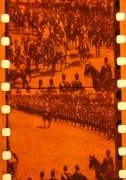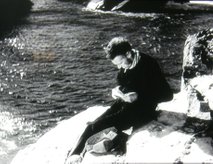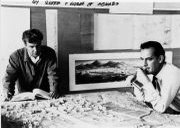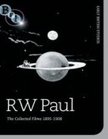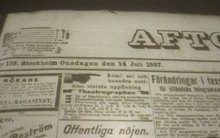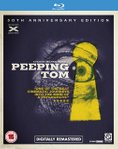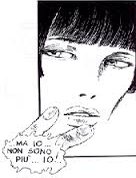Measuring Film's New Cultural Impact
Back to... The Edge of the World, The Red Shoes and Peeping Tom
Michael Powell's breakthrough film,
The Edge of the World (1937), has
reappeared in Blu-ray format, with all
the extras from the BFI's earlier DVD -
commentary by Thelma Schoonmaker
and me, readings from Powell's book
of the film by Daniel Day-Lewis, and
I’ve written a new booklet essay.
Also new are the Criterion and ITV
Studios versions of Powell and
Pressburger’s The Red Shoes, both in
Blu-ray and DVD, and based on the
new Film Foundation restoration.
Criterion retains the original extras, with
interviews and commentary by yrs truly.
And Peeping Tom has also made the
transition to Blu-ray in a new Optimum
disc based on a recent restoration, with
my commentary.
For seven years I led an annual workshop for staff from Europa
Cinemas members at the Bologna
Cinema Ritrovato Festival, where we
discussed how to link the 'old'
experience of cinema with contem-
porary culture and especially e-media.
Happily this continues today, as the
Innovation Lab, led by Maddie Probst.
In 2009, I contributed to a study for
the UK Film Council, Stories We Tell
Each Other: The Cultural Impact of
British Film, which explored how film's
'long tail' in digital media and the on-
line blogosphere are amplifying film's
cultural impact. This and a later
report, Opening Our Eyes (2011) are
both online at the BFI website (also
slides from presenting the report with
my co-authors Bertrand Moullier and
Silvia Angrisani. .
Copyright ® 2017.ianchristie.org
Recent and forthcoming publications
The Art of Film: John Box
and Production Design
John Box seen here planning to build Aqaba
from scratch - and in Spain rather than
Jordan - with his art director Terry Marsh, for
the famous charge in Lawrence of Arabia.
John won four Oscars and four BAFTAs for
his spectacular yet often unobtrusive
production design during a career that
stretched from the end of the British studio
system in the late1940s to the early days of
CGI on the mid 90s.
My book, based on interviews with John and
surveying his full career, was published by
Wallflower, with a grant from the David Lean
Foundation, in July 2009.
Another essay on production design appeared
in Conjuring the Real: the Role of Architecture
in 18th and 19th century fiction, edited by
Rumiko Handa and James Potter (University
of Nebraska Press, 2011)
A new essay on production design,
'Crafting Worlds: the Changing Role of
the Production Designer', will appear in a
collection of essays entitled Framing Film,
from Intellect in 2012.
* * *
Also due to appear during 2012 are:
- A chapter on Russian documentary for the
BFI Companion to Documentary, edited by
Brian Winston.
- A chapter in the Companion to Jean Renoir,
edited by Ginette Vincendeau and Alastair
Philips (Blackwell), on Renoir's reputation.
- An essay on early film accompaniment
practices in London, in a collection Sounds of
Early Cinema in Britain, edited by Julie Brown
and Annette Davison.
- An essay on the role of ancient-world epics
in developing cinema's new centrality in
early 20th century entertainment, for a collect-
ion edited by Maria Wyke and Pantelis
Michelakis on The Ancient World in Silent
Cinema
- My cointribution to the proceedings of the 2010
Domitor Conference in Toronto, on 'Film as
defined in British Law before 1910'.
Researching R W Paul
Twelve years ago, after writing and co-producing a television series on early cinema and what led up to it - The Last Machine (BBC2, 1994) - I began to research the enigmatic figure of Robert Paul (1866-1943), who produced Britain's first commercial 'animated photo-graphs' in 1895 (in a controversial partnership with Birt Acres). Paul went on to help launch the British film industry before closing his studio in 1909, to concentrate on scientific instrument making.
My work on Paul has continued intermittently, with discoveries about his private life, viewing a remarkable original print of one of his films of Queen Victoria's 1897 Jubilee (top left) in the BFI National Archive, and curating a BFI DVD of Paul's extant films in 2006.
In November 2010, a visit to Stockholm allowed me to investigate Paul's visit in 1897. He was there at the invitation of the King, to install and demonstrate a film projector. He also shot a series of films of typical Swedish scenes, which are all lost but known from his sales catalogues.
What I discovered from the newspapers was that a programme of his films ran for three months in Stockholm at the Salon International, which means he must have trained an operator and left copies. Could they still exist somewhere?
Spurred on by this and other discoveries, I now hope to finish the long-promised book on Paul and the early moving picture business during 2017, in time to celebrate the 150th anniversary of Robert Paul in 2019.
Some DVDs I've contributed to, with commentaries and/or booklet essays
.
About Me
Ian Christie
I'm a film historian, curator, broadcaster and consultant, and have been Anniversary Professor of Film and Media History at
Birkbeck College, University of London, since 1999. I have written and edited books on early film, Powell and Pressburger, Russian
cinema, Scorsese and Gilliam (further details elsewhere on this site); and worked on exhibitions ranging from Film as Film
(Hayward,1979), Eisenstein: His Life and Art (MoMA Oxford, 1988) and Twilight of the Tsars (Hayward, 1991) to Spellbound: Art
andFilm (Hayward, 1996) and Modernism: Designing a New World (V&A, 2006). I also contribute regularly to radio and television
programmes on cinema. These have included essays on Harold Pinter as screenwriter and on Bach as a film composer for Radio
Three, as well as interviews for The Hundred Scariest Movies, The Thirties in Colour (BBC4), Scotland on Screen (BBC2), Rude
Britannia, Dive! Dive! Dive!, Strictly Courtroom and Epics (BBC4).
Having been involved with pan-European media initiatives since the 1980s, I am currently a vice-president of Europa Cinemas and
member of its Experts Committee. I was elected a fellow of the British Academy in 1994 and in 2005-06 was Slade Professor of
Fine Art at Cambridge University, with a series of lectures entitled 'The Cinema Has Not Yet Been Invented'. Recent lectures have
included the first Richard Gregory Lecture for the Bristol Vision Institute at Bristol University ('What do we see in Films?'), the Nick
Burton Memorial Lecture at Christchurch University, Canterbury (‘Blind Spots: What about the History that's not on Screen?'), and
the 2010 Holden Lecture at Senate House, London University (‘Something Stirring in the Stack? Why filmmakers enter the
Library’). Details of recent conferences, symposia and presentations appear on the front page of thew website
As a member of the Steering Group of London's Screen Archives Regional Network, I launched the London Screen Study
Collection at Birkbeck in 2006, and currently serve on the UK Screen Heritage Programme Board. I am also an adviser to the London
Film Museum, and a member of the Intellectual Property Office's advisory committee.
Current research interests include the history of production design, early (and new) optical media, the cultural impact of film in the digital
era and the potential of experimental psychology and cognitive neuroscience to tell us more about what (and why) we experience on
screen. Plus continuing fascination with the work and careers of Sergei Eisenstein, Michael Powell, Martin Scorsese, Terry Gilliam, Raul
Ruiz, Aleksandr Sokurov, Patrick Keiller and some other notable individualists among filmmaking folk.
